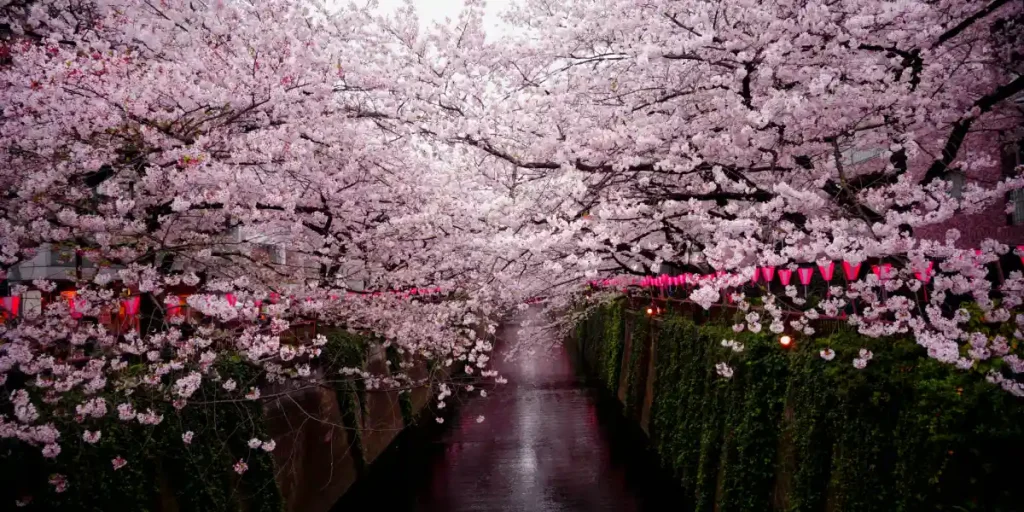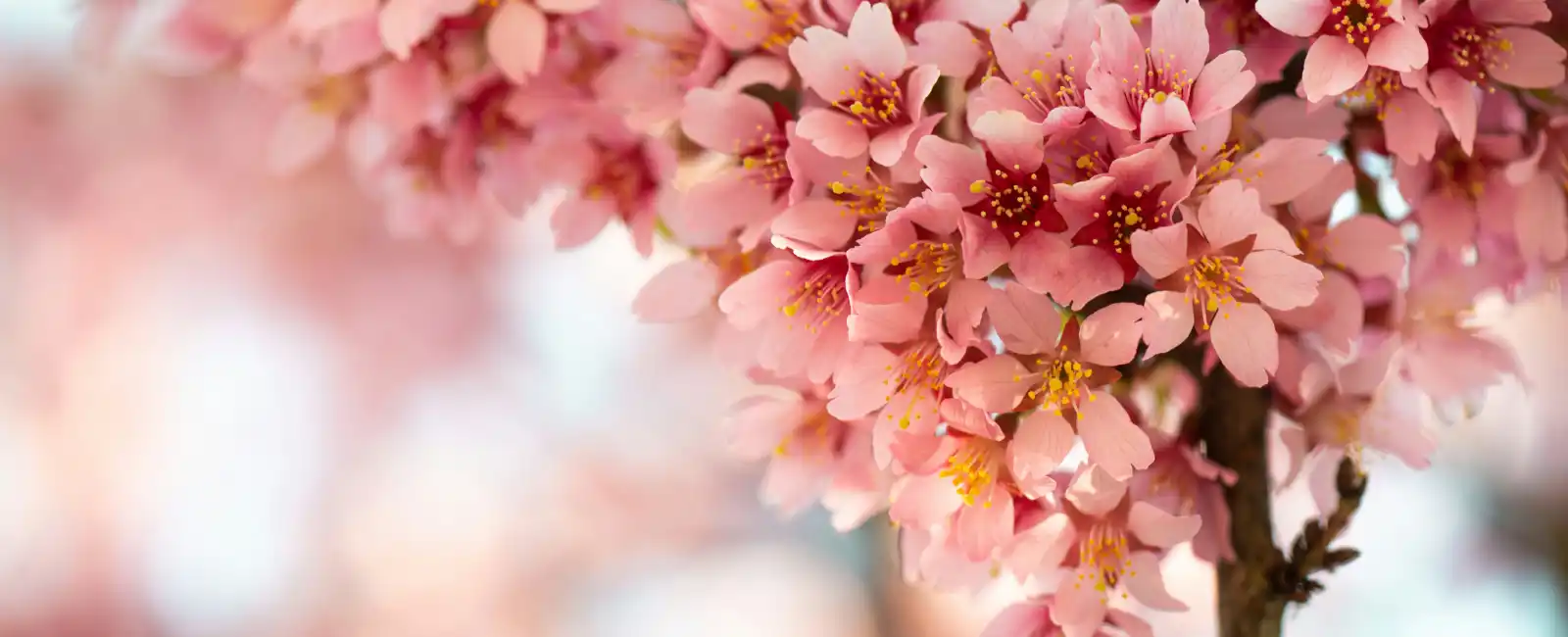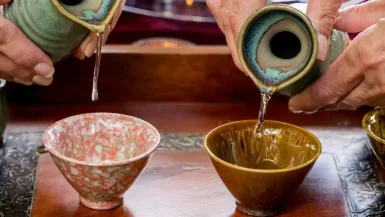Japan is a land of timeless beauty, where tradition and modernity seamlessly blend. One of the most profound symbols of this cultural tapestry is the sakura, or cherry blossom. Renowned for its fleeting yet breathtaking bloom, sakura holds a special place in Japanese hearts and minds. In this blog post, we will explore Sakura in Japanese Culture as a symbol of transience and beauty.
The Historical Roots of Sakura
To truly appreciate the sakura’s significance, one must delve into its historical roots. The cherry blossom has been celebrated in Japan for over a thousand years, with its earliest mentions dating back to the Nara period (710-794 AD). During this time, the Japanese aristocracy began to hold flower-viewing parties, or hanami, under blooming sakura trees. This practice was heavily influenced by Chinese customs, yet it soon evolved into a distinct Japanese tradition.
In the Heian period (794-1185 AD), the cultural significance of sakura blossomed further. It was during this era that the imperial court popularized hanami, transforming it into an essential part of Japanese culture. Poets and artists were particularly captivated by the cherry blossom, often using it as a metaphor for the transient nature of life. This period saw the creation of many waka poems and paintings that immortalized the ethereal beauty of sakura.
Sakura in Japanese culture as a Symbol of Ephemerality
The fleeting nature of sakura blooms, which typically last only a week or two, is a poignant reminder of life’s transience. This concept, known as mono no aware, or the awareness of impermanence, is a cornerstone of Japanese aesthetics and philosophy. Sakura blossoms, with their short-lived beauty, perfectly encapsulate this sentiment.
Throughout Japanese literature, the cherry blossom is often used to symbolize the ephemeral nature of life. For instance, in “The Tale of Genji,” a classic work of Japanese literature, the sakura is frequently referenced to highlight the fleeting moments of beauty and sorrow experienced by the characters. Similarly, haiku poets like Matsuo Basho and Kobayashi Issa have penned countless verses capturing the delicate and transient beauty of sakura.
Sakura in Japanese Festivals and Rituals
The cultural importance of sakura is vividly evident during the annual hanami season. Hanami, which literally means “flower viewing,” is a beloved Japanese tradition where people gather to admire the cherry blossoms. This custom dates back to the Heian period, but it has evolved significantly over the centuries.
Today, hanami is celebrated with great enthusiasm across Japan. Families, friends, and colleagues come together for picnics under blooming sakura trees, enjoying food, drinks, and each other’s company. Popular hanami spots like Ueno Park in Tokyo, Maruyama Park in Kyoto, and Himeji Castle in Hyogo attract thousands of visitors each year. The festive atmosphere is often enhanced by traditional music, dance performances, and various local delicacies.
Beyond hanami, sakura also plays a vital role in other Japanese rituals and festivals. For instance, the Sakura Matsuri, or cherry blossom festival, is a major event in many cities. This festival features parades, cultural performances, and food stalls, all centered around the celebration of cherry blossoms. Additionally, sakura petals are often used in religious ceremonies, symbolizing purity and the fleeting nature of life.
Certainly, the seasons of festivals are the best times to visit Japan. Read more details here.

Sakura in Modern Japanese Culture
Sakura In Japanese culture continues to hold immense cultural significance. The cherry blossom has become a national symbol, representing the country’s unique blend of tradition and modernity. Its image is ubiquitous, appearing on everything from currency and official documents to consumer products and advertising.
The influence of sakura extends beyond Japan’s borders as well. The annual cherry blossom forecast, which predicts the blooming dates across different regions, is eagerly awaited by both locals and international tourists. This forecast, provided by the Japan Meteorological Agency, plays a crucial role in planning hanami gatherings and travel itineraries.
Moreover, the cherry blossom has inspired countless works of art, literature, and music in modern Japan. From classic ukiyo-e woodblock prints to contemporary anime and manga, sakura continues to captivate the imagination of artists and creators. Musicians, too, have composed many songs celebrating the beauty and symbolism of cherry blossoms, further cementing their place in Japanese culture.
The Global Appeal of Sakura
While sakura is deeply rooted in Japanese culture, its appeal has transcended national boundaries. Cherry blossom festivals are now celebrated in various parts of the world, including the United States, Canada, the United Kingdom, and several Asian countries. These international festivals often feature cultural performances, traditional Japanese cuisine, and, of course, the breathtaking beauty of cherry blossoms. In addition to these events, many cities and towns plant cherry trees to honor the tradition and welcome spring with vibrant colors.
For example, in Vancouver, the cherry blossom season brings a stunning display of pink and white blossoms, attracting locals and tourists alike. Furthermore, the cherry blossoms’ symbolism of renewal and hope resonates with people from diverse backgrounds, making these festivals meaningful across cultures. As a result, the global celebration of cherry blossoms fosters cross-cultural understanding and appreciation. Overall, sakura’s influence extends far beyond Japan, enriching springtime celebrations around the world with its delicate beauty and cultural significance.
Sakura and Environmental Awareness
In recent years, the cultural significance of sakura has also intersected with environmental awareness. The preservation and conservation of cherry blossom trees have become important issues in Japan and beyond. Many organizations and local communities are actively involved in planting and maintaining sakura trees, ensuring that future generations can continue to enjoy their beauty.
Moreover, the cherry blossom season serves as a reminder of the delicate balance of nature. Climate change and environmental degradation pose significant threats to the natural habitats of sakura trees. As a result, the blooming patterns of cherry blossoms have become an important indicator of environmental health. Efforts to protect and preserve these iconic trees are crucial in safeguarding the cultural and natural heritage they represent.
The Culinary Delights of Sakura
The influence of sakura extends beyond the visual and symbolic realms into the culinary world. Cherry blossoms and leaves enhance various traditional Japanese dishes and sweets with their unique flavor and aesthetic appeal. For example, sakura mochi is a popular springtime treat consisting of sweet rice cake wrapped in a pickled cherry blossom leaf. This combination provides a delicate floral aroma and a distinct taste that celebrates the season. Additionally, chefs use cherry blossoms to flavor soups, teas, and even savory dishes, showcasing their versatility. In many recipes, the blossoms contribute both visually and gastronomically, making the dishes more memorable. The use of cherry blossoms in cuisine reflects Japan’s deep appreciation for seasonal ingredients and cultural traditions. As you explore Japanese food, you’ll find that cherry blossoms play a significant role in creating seasonal and festive flavors. Ultimately, these ingredients offer a taste of Japan’s rich culinary heritage. The subtle fragrance and delicate taste of sakura make it a cherished ingredient in Japanese cuisine.
During the hanami season, many restaurants and food vendors offer sakura-themed dishes and beverages. Sakura-flavored drinks, such as sakura tea and sakura sake, are particularly popular. These culinary delights not only celebrate the beauty of cherry blossoms but also offer a sensory experience that enhances the hanami tradition.
The Future of Sakura in Japanese Culture
As Japan continues to evolve, the significance of sakura remains steadfast. The cherry blossom, with its timeless beauty and profound symbolism, will undoubtedly continue to inspire and captivate future generations. However, the challenges posed by environmental changes and urbanization highlight the need for ongoing conservation efforts.
Education and awareness are key to ensuring the preservation of sakura trees and the traditions associated with them. By fostering a deeper understanding of the cultural and environmental importance of cherry blossoms, we can contribute to their protection and celebrate their enduring legacy.
Conclusion
In conclusion, sakura is much more than a beautiful flower in Japan; it is a symbol of the nation’s cultural heritage, a reminder of life’s fleeting nature, and a source of inspiration and joy. From its historical roots in ancient Japan to its modern-day celebrations and global influence, the cherry blossom continues to hold a special place in the hearts of many. Throughout history, sakura has inspired countless poets, artists, and filmmakers, who have captured its essence in their works. During the cherry blossom season, communities across Japan come together to celebrate with hanami parties, enjoying picnics under the blooming trees. Additionally, sakura-themed products, such as cosmetics, beverages, and snacks, reflect its widespread appeal and influence.
As we admire the delicate beauty of sakura, we also recognize its role in Japanese cultural traditions and festivities. In preserving sakura’s legacy, we ensure that future generations can continue to experience and appreciate its beauty and significance. Ultimately, the cherry blossom stands as a testament to the enduring charm of Japan’s natural and cultural heritage.



